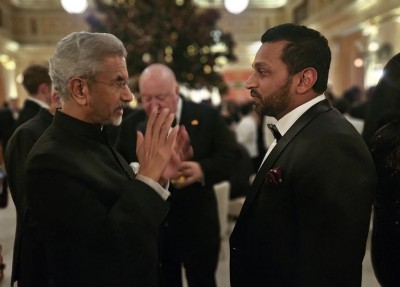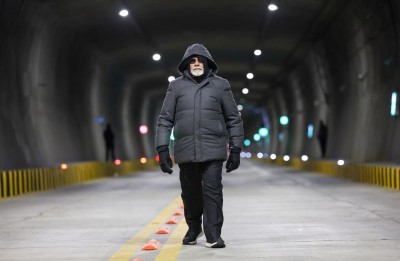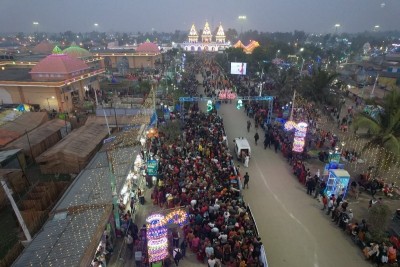January 23, 2025 05:12 pm (IST)

Speech of PM Modi at Advancing Asia event
New Delhi, Mar 12 (IBNS) Following is the full text of the speech of PM Modi's address at the MOF-IMF Conference on “Advancing Asia: Investing for the Futureâ€.
Madam Lagarde, My Cabinet colleague Shri Jaitley, Ladies and Gentlemen,
I warmly welcome you all to India and to Delhi. Delhi is a city with a rich heritage, and has several historical landmarks. I hope you will have time to see some of them.
I am very happy that the IMF has collaborated with us in organizing this conference. Madam Lagarde, this event is another example of your fondness for India and Asia. I congratulate you on being appointed as Managing Director for a second term. This reflects the confidence the world has in your understanding of the global economy, and your ability to lead this institution. Madam Lagarde, the long pending quota revisions agreed in 2010 have finally come into effect. The quotas of emerging countries will now better reflect their weight in the world economy. This will give them more say in collective decisions in the IMF. You have demonstrated exceptional leadership, in managing the tensions that emerged due to the delay. You played a major role in finally persuading all members to ratify the decisions taken in 2010.
I am sure, the IMF will be able to build on this success. Reform of global institutions has to be an on-going process. It must reflect changes in the global economy, and the rising share of emerging economies. Even now, IMF quotas do not reflect the global economic realities. Change in quotas is not an issue of increasing the ‘power’ of certain countries. It is an issue of fairness and legitimacy. The belief that quotas can be changed, is essential for the fairness of the system. For poor nations to respect the legitimacy of such institutions, they must be able to aspire and to hope. I am, therefore, very happy that the IMF has decided to finalize the next round of quota changes by October 2017.
India has always had great faith in multi-lateralism. We believe that as the world becomes more complex, the role of multilateral institutions will increase. Some of you may not be aware that India was represented at the Bretton Woods Conference in 1944, which gave birth to the IMF. India’s delegate was Mr. R.K. Shanmukham Chetty, who later became independent India’s first Finance Minister. Our ties, therefore, are more than seventy years old. We are a Founding Member of the Asian Infrastructure Investment Bank and the New Development Bank. We are confident that these banks will play an important role in the development of Asia.
The Fund has built up an immense stock of economic expertise. All its members should take advantage of this. All of us need to pursue policies that provide a stable macro economy, enhance growth and further inclusion. The Fund can be of great assistance in this.
Apart from advice, the IMF can help in building capacity for policy making. I am happy to announce a new partnership with Bangladesh, Bhutan, Maldives, Nepal, Sri Lanka, India and the IMF. We have agreed to set up the South Asia Regional Training and Technical Assistance Centre. The centre will provide training to government and public sector employees. It will enhance their skills and improve the quality of their policy inputs. It will also provide technical assistance to governments and public institutions.
Let me now turn to the theme of this conference. I will touch on two issues: firstly, “Why Asia?” And secondly, “How India”? Why is Asia so important, and how can India contribute?
Many knowledgeable people have said that the twenty first century is, and will be, the Asian Century. Three out of every five people in the world live in Asia. Its share in global output and trade is now close to one-third. Its share in global foreign direct investment is about forty percent. It has also been one of the world’s most dynamic regions. Although Asia has slowed down, it is still growing at a rate three times greater than that of the advanced countries. It is, therefore, the ray of hope for global economic recovery.
When we think about Asia, we must recognize that it is distinct in many ways.
For example, the theme of this conference is ‘Investing for the Future’. Asian Families tend naturally to save more than people in other parts of the world. Thus they invest for the future. Economists have commented on the savings ethic of Asian countries. Asians tend to save to buy a house, rather than borrow to buy a house.
Many Asian countries have relied more on developmental financial institutions and banks than on capital markets. This provides an alternative model for the financial sector.
Social stability built on strong family values is another feature of Asia’s development. Asians tend to leave things behind for the next generation.
Madam Lagarde, you are one of the world’s top women leaders. You will be interested in another unique feature of Asia which is rarely commented upon: which is, the large number of women leaders. India, Sri Lanka, Bangladesh, Pakistan, Indonesia, Thailand, Korea, Myanmar, and Philippines: All of these countries have had women as national leaders. Asia has done so to a much greater degree than other continents. Today, four large states of India – West Bengal, Tamil Nadu, Gujarat and Rajasthan – are headed by democratically elected women. The Speaker of the Lower House of Parliament in India is also a woman.
India has a special place in Asia. It has historically contributed to Asia in several ways. Buddhism spread to China, Japan, and other parts of South East Asia from India. It has had a lasting influence on the continent’s culture. Kingdoms in the South and West of India have engaged in maritime trade with other parts of Asia for over a thousand years. The Indian national movement showed other Asian countries that freedom from colonial rule could be achieved without violence. It also demonstrated clearly that the sense of nationhood, could be broad and inclusive. It need not be defined by narrow linguistic or religious identities. The Sanskrit saying “Vasudhaiva Kutumbakam” – the world is one family - refers to this sense of the oneness of all identities.
India has dispelled the myth that democracy and rapid economic growth cannot go together. India’s growth rate of over seven per cent is being achieved in a country that is also a vibrant democracy. It is sometimes assumed that democracy is a colonial gift to India. But historians tell us that India had produced forms of democratic self governance, many centuries ago, when democracy was unknown in many parts of the world.
India has also shown that a large, diverse country can be managed in a way that can promote economic growth and maintain social stability. One way in which we are doing this is through cooperative and competitive federalism. The states and the Centre come together to pursue common objectives. States which pursue good policies and deliver essential services for the poor, induce others to follow.
Our rapid economic growth is also very distinct in Asia. We have never tried to gain in trade at the expense of our partners. We do not follow “beggar thy neighbour” macro-economic policies. We have never undervalued our exchange rate. We add to world and Asian demand by running current account deficits. We are therefore good Asian and good global economic citizens, and a source of demand to our trading partners.
We all want Asia to succeed. I firmly believe that India can contribute to Asian prosperity and development by being economically strong. Amid global problems, I am happy to say that India is a haven of macro-economic stability and a beacon of hope, dynamism and opportunity. Madam Lagarde, you have referred to India as the “bright spot” in the global economy. I view this as a great privilege and, at the same time, a major responsibility. Let me outline our achievements in the last few months and our priorities for the period ahead.
We have achieved major gains in macro-economic stability. A durable reduction in inflation, steady fiscal consolidation, a comfortable balance of payments position and build-up of foreign exchange reserves are the highlights.
In a difficult external environment and despite a second successive year of weak rainfall, we have increased our growth rate to 7.6 per cent, the highest among major economies in the world.
We have improved our economic governance. Corruption and interference in the decisions of banks and regulators are now behind us.
 We undertook a highly successful financial inclusion programme, bringing over two hundred million unbanked people into the banking system within a span of a few months.
 Thanks to our financial inclusion programme, we now have the world’s largest and most successful programme of direct benefit transfers, in cooking gas. We plan to extend it to other sectors such as food, kerosene, and fertilizers. This has improved targeting and the quality of public expenditure.
 We have opened up nearly all sectors of our economy to FDI.
 India achieved the highest ever rank in the World Bank Doing Business indicators in 2015.
 India reached an all-time high in many physical indicators in 2015, including
 the production of coal, electricity, urea, fertilizer and motor vehicles;
 cargo handled at major ports and the fastest turnaround time in ports;
 award of new highway kilometers;
 software export;
 Entrepreneurship is booming, following a series of steps we have taken. India is now fourth in the world in the number of technical start-ups, after USA, Britain and Israel. The Economist magazine has called India the new frontier for E-Commerce.
We do not intend to rest on these achievements because my agenda of “reform-to-transform” still needs to be finished. Our recent budget provides a roadmap for our future plans and ambitions. Our underlying philosophy is clear: To create the climate for wealth generation and for that wealth to be spread to all Indians, especially the poor, vulnerable, farmers, and disadvantaged communities.
We have increased investment in the rural and agriculture sector, because that is where a majority of India still lives. But our help to the farmers is not based on giving hand-outs. We aim to double farmer incomes by: • increasing irrigation,
• better water management,
• creating rural assets
• boosting productivity,
• improving marketing,
• reducing margins of middlemen
• and avoiding income shocks.
We are introducing reforms in agricultural marketing and have launched a major crop insurance programme.
In addition to agriculture, we have increased public investment in roads and railways. This will improve the productivity of the economy and the connectivity of our people. Public investment is also essential at a time when private investment remains weak.
We have also made other reforms that will help create wealth and economic opportunity. Given the enormous entrepreneurial potential in the country, my motto is Start Up India and Stand Up India. The budget has provided a further boost to the ecosystem for start-ups.
Ensuring employability of the youth is essential for the success of our Make-in-India campaign. The Government of India has an ambitious agenda for skilling our labour force. Skill creation of the magnitude that we have envisaged, involves institution building, which we have undertaken. Now, we have a skill development programme that cuts across twenty-nine sectors and with a nation-wide coverage.
India is a responsible global citizen in protecting the planet. India played a positive role at the COP 21 Summit. Between now and 2030, we intend to re-write history by growing rapidly and also reducing the emission intensity of our GDP by thirty-three per cent. By then, forty per cent of our installed electric power capacity will be from non-fossil fuel. We will build an additional carbon sink of over 2.5 billion tonnes of carbon dioxide equivalent by 2030, by creating additional forest and tree cover. These initiatives are from a country with very low per capita land availability and a low base of per capita emission. We have taken the lead in launching an international solar alliance, involving 121 solar-resource rich countries falling between the Tropic of Cancer and the Tropic of Capricorn. This will help many developing countries, including those in Asia, to take advantage of developments in renewable energy. India has moved from a regime of significant carbon subsidy to one of carbon taxes. India is one of the few countries to have a carbon tax in the form of a cess on coal. The Coal cess has been doubled in the Budget of 2016-17.
India has a number of cooperative initiatives in Asia. We are transforming the ‘Look East Policy’, into an ‘Act East Policy. Our approach to cooperation is based on flexible geometry. We have integrated in different ways and at different speeds with our neighbours in South Asia, our partners in ASEAN, and our partners in Singapore, Japan, and Korea. We intend to continue doing so.
My dream is of a Transformed India. I lay this dream alongside our common dream of an Advanced Asia – an Asia where more than half of the global population can live with happiness and fulfillment. Our joint heritage and mutual respect, our common goals and similar policies, can and must create sustainable growth and shared prosperity.
Once again, I welcome you all to India. I wish the Conference all success.
Thank you.
Support Our Journalism
We cannot do without you.. your contribution supports unbiased journalism
IBNS is not driven by any ism- not wokeism, not racism, not skewed secularism, not hyper right-wing or left liberal ideals, nor by any hardline religious beliefs or hyper nationalism. We want to serve you good old objective news, as they are. We do not judge or preach. We let people decide for themselves. We only try to present factual and well-sourced news.
Support objective journalism for a small contribution.
Latest Headlines
Indian couples in US rush for C-sections as deadline for Trump's law ending birthright citizenship nears
Thu, Jan 23 2025
'Will accept an auto rickshaw but not reward': Driver who rushed wounded Saif Ali Khan to hospital
Thu, Jan 23 2025
'He was dancing while walking': Maharashtra minister Nitesh Rane doubts Saif Ali Khan's stabbing incident
Thu, Jan 23 2025
JDU sacks Manipur Chief after he declares to withdraw support from BJP government in state
Wed, Jan 22 2025
12 dead after passengers jump off train in Maharashtra over rumours of fire and collision with another train
Wed, Jan 22 2025







